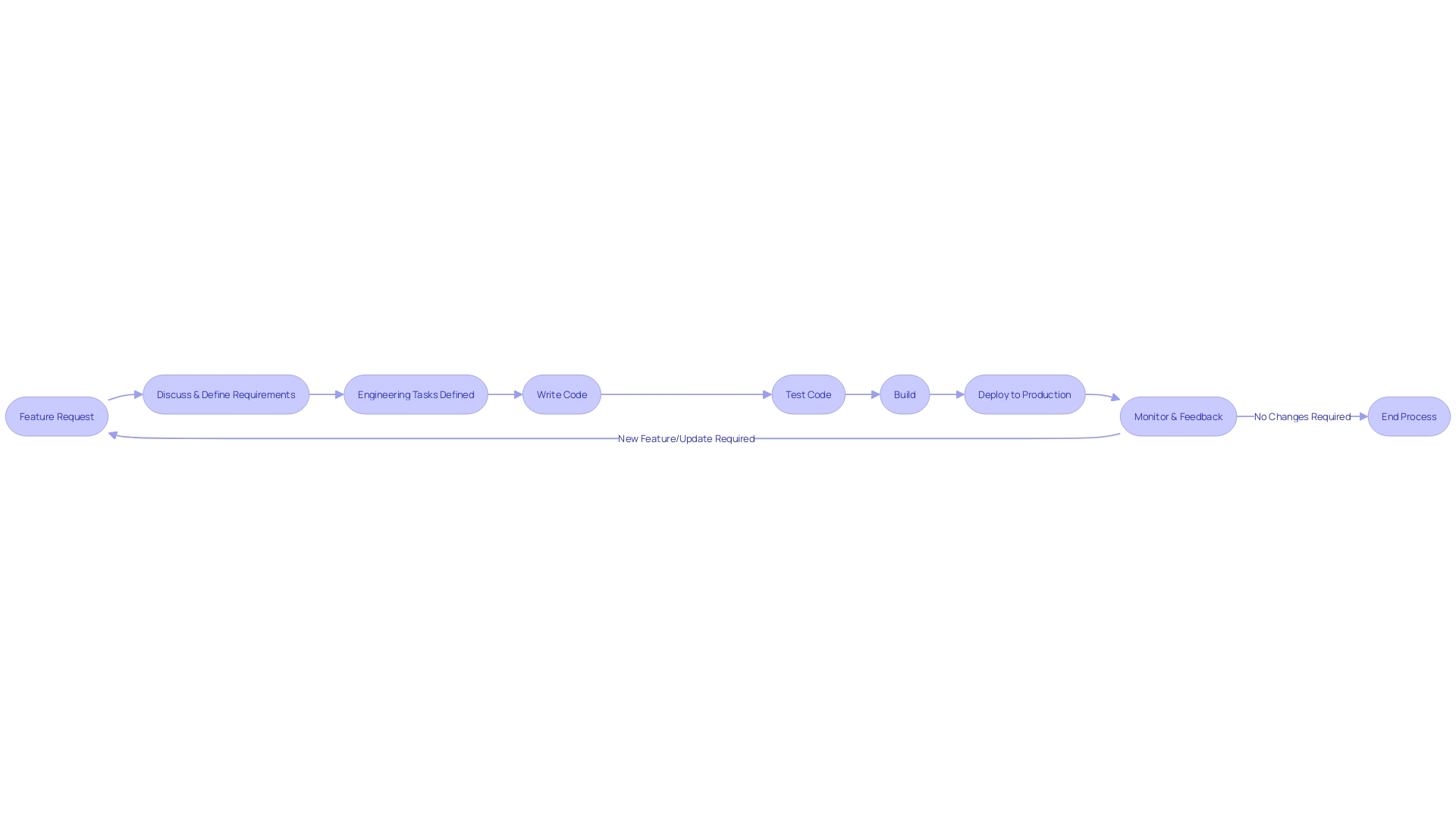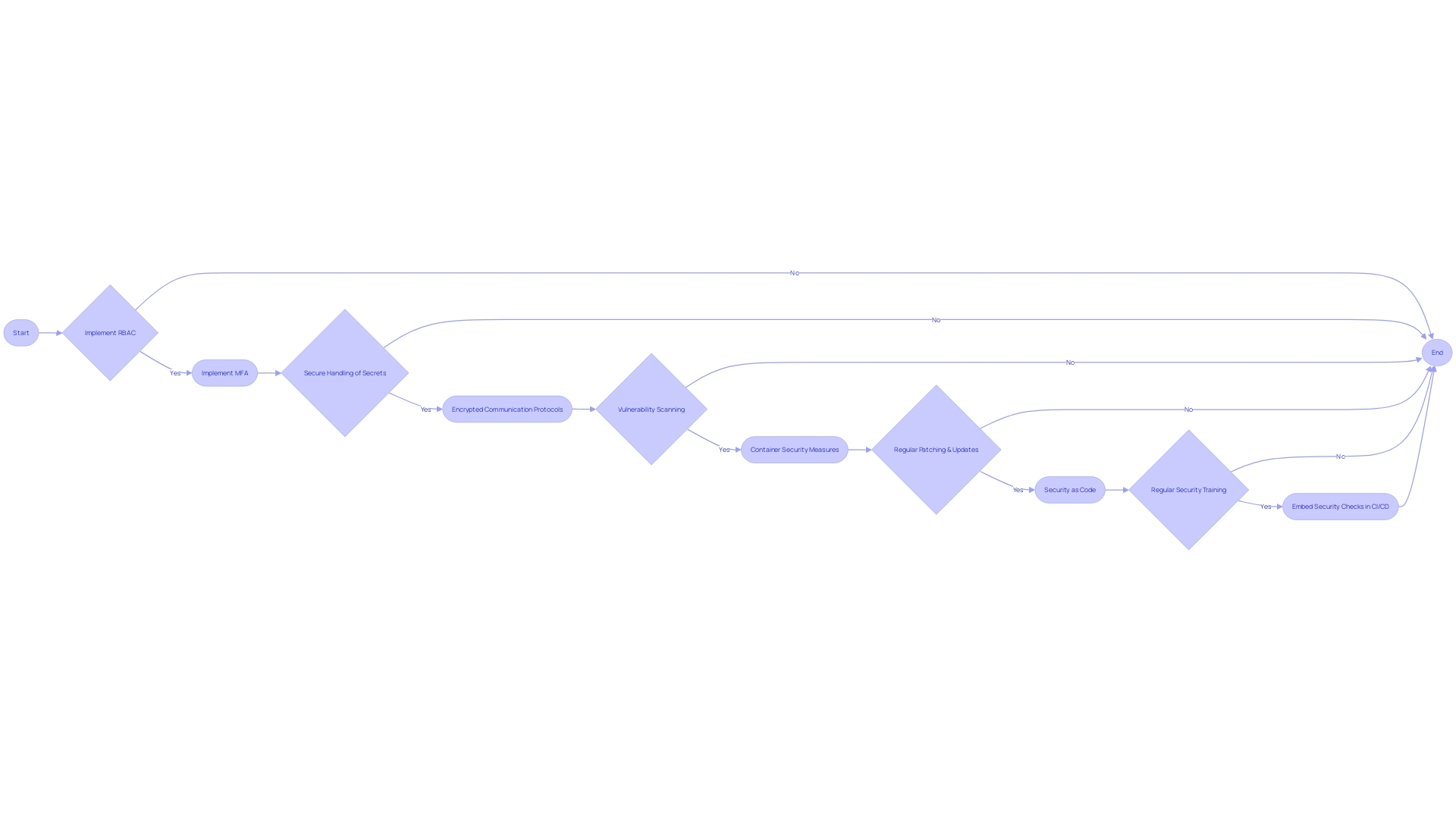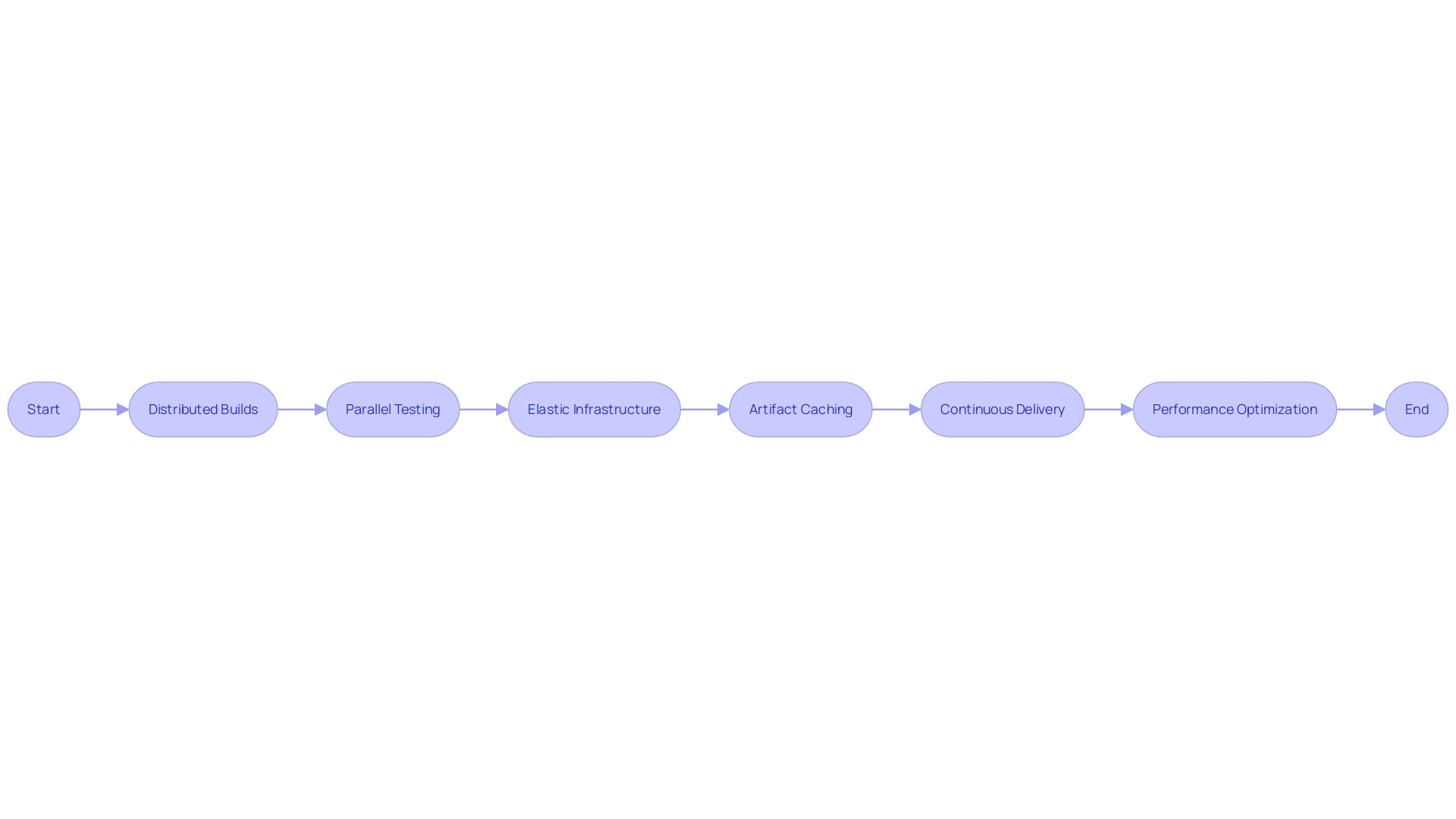Introduction
The Continuous Integration/Continuous Deployment (CI/CD) pipeline is a transformative framework that optimizes the software development lifecycle, enabling smoother transitions from coding to deployment. At its core, it consists of key stages, each playing a critical role in streamlining the process. These stages include Source Code Management, Build, Test, Deployment, and Monitoring and Feedback.
By understanding and implementing these stages, leading e-commerce companies have been able to overcome integration challenges and accelerate product releases. In this article, we will explore the importance of CI/CD pipelines, best practices for their implementation, the role of automation, security considerations, and strategies for scaling and optimizing pipelines. By delving into these topics, developers can gain valuable insights into building efficient and reliable CI/CD pipelines that drive excellence in software development.
Understanding CI/CD Pipeline Stages
The Continuous Integration/Continuous Deployment (CI/CD) pipeline is a transformative framework that enhances the programming lifecycle, enabling smoother transitions from coding to deployment. At its core, it consists of key stages, each playing a critical role in streamlining the process.
-
Source Code Management: This foundational stage is where the collaborative efforts of development teams converge. Utilizing tools like Git, it provides a robust platform for version control, facilitating simultaneous code contributions and feature integration.
-
Build: Here, raw source code is transformed into functional applications through compilation and the resolution of dependencies. This stage produces essential build artifacts that are required for the subsequent stages of the process.
-
Test: Automated testing is conducted to ensure the integrity and performance of the software. This includes various test types, from unit to integration tests, acting as a quality gatekeeper before proceeding further in the pipeline.
-
Deployment: The transition from testing to a live environment occurs here. Whether deploying to development, staging, or production environments, this stage is critical for the application's lifecycle, involving infrastructure provisioning and service configuration.
-
Monitoring and Feedback: Post-deployment, this stage focuses on ongoing surveillance of the application's performance. It's a feedback loop for detecting issues and fostering continuous refinement of the program.
These stages symbolize the flywheel of continuous integration and continuous deployment, a concept compared to the careful assembly of a puzzle, where each piece is crucial to the larger image. As mirrored in the statements of industry professionals, continuous integration and continuous delivery is not only a technical endeavor but a strategic facilitator that drives software development towards greatness.
In practice, prominent e-commerce companies have utilized CI/CD systems to overcome integration challenges and expedite product releases, such as the deployment of an AWS CI/CD framework that automated code integration and standardized release procedures. Such real-world applications underscore the pipeline's significance in achieving quality and efficiency.
Continuous integration stands at the heart of the process, as noted in recent advancements in the field. It serves as a safeguard against data exposure risks and cyber threats, highlighting the ongoing development of continuous integration and continuous delivery practices. Developers, such as Yashvi Kothari and Mishi, are leading the way, curating systems that not only fulfill but exceed the demanding requirements of contemporary programming.

Setting Up a CI/CD Pipeline
Starting a CI/CD process is a transformative strategy that improves code quality and speeds up the development cycle, making it essential in modern software engineering. The following steps encapsulate the pipeline's creation:
-
Formulating the Pipeline's Blueprint: Crafting a pipeline begins by detailing its architecture, which encompasses stages, tasks, and how they interconnect. This structural plan must be tailored to the unique demands of your project, considering the tools you aim to integrate.
-
Choosing the appropriate platform for continuous integration and continuous deployment is crucial, as it should align with your project requirements and seamlessly integrate into your development environment. Well-known platforms such as Jenkins, GitLab, CircleCI, and AWS CodePipeline, each provide distinctive features and integrations.
-
Integrating Source Code Management (SCM): Incorporating SCM, such as Git, is pivotal. It allows the continuous integration and continuous deployment platform to access the latest code revisions and start pipeline processes automatically.
-
Establishing Build Configuration: The build phase is critical; it involves code compilation, dependency resolution, and artifact creation. This step requires defining build commands and scripts that align with your project's requirements.
-
Automating Testing Procedures: Automated testing is a foundation of continuous integration and continuous delivery, covering unit, integration, and other test forms. It's essential to delineate testing frameworks, data, and environments to ensure code robustness.
-
Streamlining Deployment: Deployment setup includes infrastructure provisioning, service configuration, and application rollout. Deployment targets must be clearly specified along with the deployment scripts or configurations.
-
Implementing Monitoring and Feedback Loops: Effective monitoring tools and feedback mechanisms are vital. They assist in monitoring application performance and health, ensuring that any concerns are quickly communicated to the team.
A carefully planned continuous integration and continuous deployment system not only improves the process but also ensures efficient and reliable application deployment. Recent findings from the Docker State of Application Development Report highlight the importance of continuous integration and continuous deployment, showing a rise in the implementation of these methods and a growing tendency of developers using multiple technologies for continuous integration and continuous deployment simultaneously. This change emphasizes the significance of a well-coordinated procedure for continuous integration and continuous deployment in the current landscape of creating programs.
Best Practices for CI/CD Pipelines
Attaining excellence in software engineering requires the adoption of Continuous Integration (CI) and Continuous Deployment (CD) workflows. These best practices, which are integral to CI/CD pipelines, are designed to enhance the efficiency, reliability, and maintainability of the development process:
- Simplicity is Key: When architecting CI/CD pipelines, it's imperative to concentrate on essential stages and tasks. A simplistic approach enables more straightforward management and expedites the resolution of issues.
- Automation is Crucial: Automation should be pervasive across the process, encompassing code compilation, testing, deployment, and monitoring. This approach not only diminishes manual labor but also mitigates errors and accelerates the delivery cycle.
- Version Control as a Foundation: Storing source code in a system like Git facilitates collaboration, code review, and the ability to revert to prior versions when necessary.
- Continuous Testing for Quality Assurance: Embedding automated testing within each phase is essential for early detection of defects, ensuring deployment of superior code.
- Embrace Continuous Integration: Regular code commits and integrations to the main branch are vital for timely testing and merging, reducing conflict and integration challenges.
- Incremental Deployment Strategy: Deploying in small, manageable updates rather than large overhauls minimizes the disruption from potential issues, allowing for quicker remediation.
- Monitoring and Analytics for Insight: Incorporating tools for real-time application monitoring and data analysis is crucial to identify and act on improvement opportunities.
By adhering to these best practices, programmers can create continuous integration and continuous deployment pipelines that not only streamline the process but also enhance the quality, leading to more rapid and dependable releases. The flywheel for continuous integration and continuous deployment - a metaphor for the entire lifecycle of creating and releasing software - highlights the significance of these procedures, from conceiving features to effectively deploying them in production environments.
The significant influence of continuous integration and continuous deployment on the landscape of creating computer programs is similar to finishing a puzzle with accuracy and rapidity, where every piece is carefully confirmed and positioned. According to industry news and studies, adopting continuous integration and continuous delivery is not just a technological upgrade but a strategic necessity that drives innovation, improves product quality, and strengthens security, all while simplifying complex processes. The game-changing capacity of continuous integration and continuous deployment in promoting a sustainable and pleasurable growth encounter is progressively acknowledged as the foundation of flourishing enterprises.
Implementing Automation in CI/CD Pipelines
Incorporating automation in the continuous integration and continuous deployment process is crucial for improving efficiency and minimizing mistakes in the software development life cycle. Consider these pivotal elements:
-
Infrastructure as Code (IaC): Adopting IaC tools, like Terraform or AWS CloudFormation, is essential. They enable you to manage infrastructure with code, promoting consistency and streamlining provisioning.
-
Configuration Management: Tools such as Ansible, Puppet, or Chef play a vital role in automating configuration, ensuring environment stability and preventing drift.
-
Continuous Integration: Employing CI tools like Jenkins or GitLab CI/CD automates code integration, triggering builds and tests with each repository update.
-
Automated Testing: Integration testing frameworks, for example, JUnit or Selenium, to conduct tests at every stage. Tools like SonarQube are invaluable for maintaining code quality.
-
Deployment Automation: Utilize tools like AWS CodeDeploy or Kubernetes to automate deployment processes, enabling consistent and error-free releases.
-
Continuous Monitoring: By integrating tools like Prometheus or ELK Stack into the system, it enables automatic monitoring, offering valuable insights into application performance.
Considering the progress of Workable's Applicant Tracking System, it's evident that strategic automation and decision-making play a crucial role in a responsive continuous integration and continuous delivery pipeline. As Markos Fragkakis, Staff Engineer at Workable, shares, the transition from a monolithic codebase to a more distributed system necessitated a robust CI process, underpinning the importance of the elements outlined above.
In the wider technology field, the implementation of continuous integration and continuous deployment as well as automation is emphasized by industry trends. GitHub's research on Ai's integration into development and Docker's survey on application development practices reveal a growing emphasis on automation and its significance in project satisfaction and success. Furthermore, Denise Persson, the Chief Marketing Officer at Snowflake, emphasizes the vital importance of data activation in digital marketing, similar to how data-driven strategies can provide insight and enhance continuous integration and continuous deployment processes.
The combined experiences from leaders in the industry and the most recent surveys confirm the transformative effect of automation in continuous integration and continuous delivery, demonstrating a shift in approach towards more flexible, dependable, and effective delivery of programs.

Security and Isolation in CI/CD Pipelines
In the domain of software development, the creation and upkeep of continuous integration and continuous delivery systems are similar to designing an intricate security framework that not only promotes creativity but also protects the digital resources of a company. It is essential to incorporate robust practices that address the multi-faceted security and isolation challenges inherent in these pipelines.
Secure access control is paramount. By implementing role-based access control (RBAC), organizations ensure that access to tools and infrastructure for continuous integration and continuous deployment is stringently regulated, allowing permissions to align precisely with job roles. The addition of multi-factor authentication (MFA) further fortifies this defense, creating a barrier against unauthorized access.
The management of secrets is equally critical. Sensitive data such as API keys, passwords, and certificates must be handled with the utmost care. Solutions like HashiCorp Vault or AWS Secrets Manager are crucial in securing the storage and retrieval of these secrets, ensuring they remain shielded throughout the continuous integration and continuous deployment process.
Communication within the continuous integration and continuous delivery process must be securely encrypted. Protocols like HTTPS and SSH serve as encrypted channels, ensuring that data transmission remains confidential and protected from potential interception.
Vulnerability scanning is an indispensable tool in the developer's arsenal. Incorporating scanners like SonarQube or OWASP Dependency Check into the continuous integration and delivery process enables developers to proactively identify and resolve security vulnerabilities in the codebase and its dependencies.
For those utilizing containers, security is a multi-layered endeavor. Tools like Docker Security Scanning or Anchore scrutinize container images for vulnerabilities. Implementing container isolation techniques, such as operating within restricted environments or utilizing Kubernetes namespaces, provides an additional layer of security.
Lastly, the importance of regular patching and updates cannot be overstated. The landscape of cyber threats is perpetually evolving; thus, maintaining the currency of tools, infrastructure, and dependencies is crucial in mitigating known vulnerabilities.
By integrating these security practices, organizations like Workable have successfully navigated the complexities of securing their Applicant Tracking System (ATS), which has grown in lines of code and test numbers over the years. Their transition from a centralized structure to a decentralized system of services highlights the importance of a protected continuous integration and continuous delivery flow that not only supports expansion but also strengthens the development process against emerging risks.
While exploring the complexities of continuous integration and continuous deployment, let us remember the remarks of Markos Fragkakis, a Staff Engineer at Workable, who shared insights from their implementation phase, highlighting the importance of strategic decision-making to improve continuous integration processes. These insights provide a valuable perspective for those looking to refine their security strategies within continuous integration and continuous deployment environments.

Scaling and Optimizing CI/CD Pipelines
To preserve the flexibility of your progress process as it grows, adjusting your Continuous Integration/Continuous Delivery (CI/CD) systems is essential. Here are refined strategies to ensure your pipelines keep pace with your application demands:
-
Distributed Builds: As seen in Workable's experience with their Applicant Tracking System (ATS), distributing the build process across multiple agents can drastically reduce build times and facilitate parallel processing, catering to the growing codebase without compromising efficiency.
-
Parallel Testing: Implementing parallel testing on different environments or instances, similar to strategies adopted by industry leaders, can shorten testing durations and provide quicker feedback loops to teams.
-
Elastic Infrastructure: Utilizing cloud services like AWS EC2 or Azure VMs allows for on-demand scaling. This dynamic adjustment accommodates workload fluctuations, ensuring that your resources match the demand peaks without unnecessary overhead during off-peak times.
-
Artifact Caching: By storing build artifacts and dependencies, you can bypass the need to rebuild the entire codebase for each iteration. This approach mirrors the successful techniques used by companies who have streamlined their development process, thus cutting down build times significantly.
-
Continuous Delivery: Automatic deployments post-testing phase expedite the release cycle and minimize manual intervention. This continuous delivery model not only saves time but also echoes the industry's best practices for rapid software delivery.
-
Performance Optimization: Consistently assessing the performance of your continuous integration and delivery process to detect and resolve bottlenecks is essential. Optimization may involve refining build scripts, adjusting test configurations, or streamlining deployment processes, all aimed at reducing execution time.
Adopting these strategies, influenced by real-world case studies and industry news, ensures your CI/CD pipelines remain robust and efficient, capable of supporting the evolving needs of your applications.

Conclusion
In conclusion, the CI/CD pipeline is a transformative framework that optimizes the software development lifecycle. It consists of key stages, including Source Code Management, Build, Test, Deployment, and Monitoring and Feedback. By understanding and implementing these stages, companies can overcome integration challenges and accelerate product releases.
To set up a successful CI/CD pipeline, formulate a blueprint, select the right platform, integrate source code management, establish build configuration, automate testing, streamline deployment, and implement monitoring and feedback loops.
Best practices for CI/CD pipelines include simplicity, automation, version control, continuous testing, embracing continuous integration, incremental deployment, and monitoring and analytics. These practices enhance the efficiency, reliability, and maintainability of the development process.
Implementing automation within CI/CD pipelines is crucial. Elements such as Infrastructure as Code, configuration management, continuous integration, automated testing, deployment automation, and continuous monitoring play a vital role in achieving efficiency and reducing errors.
Security and isolation are essential considerations. Implement practices such as secure access control, management of secrets, encrypted communication, vulnerability scanning, and container security to safeguard digital assets and mitigate threats.
Scaling and optimizing CI/CD pipelines is imperative. Strategies such as distributed builds, parallel testing, elastic infrastructure, artifact caching, continuous delivery, and performance optimization ensure agility as the development process scales.
By following these best practices and strategies, developers can build efficient and reliable CI/CD pipelines that drive excellence in software development. The transformative potential of CI/CD pipelines in fostering a sustainable and enjoyable development experience is increasingly recognized as the cornerstone of thriving software enterprises.




